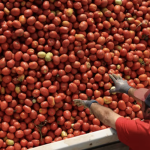Carbon Positive Project Update April 2024
Added 2 years ago
By David France
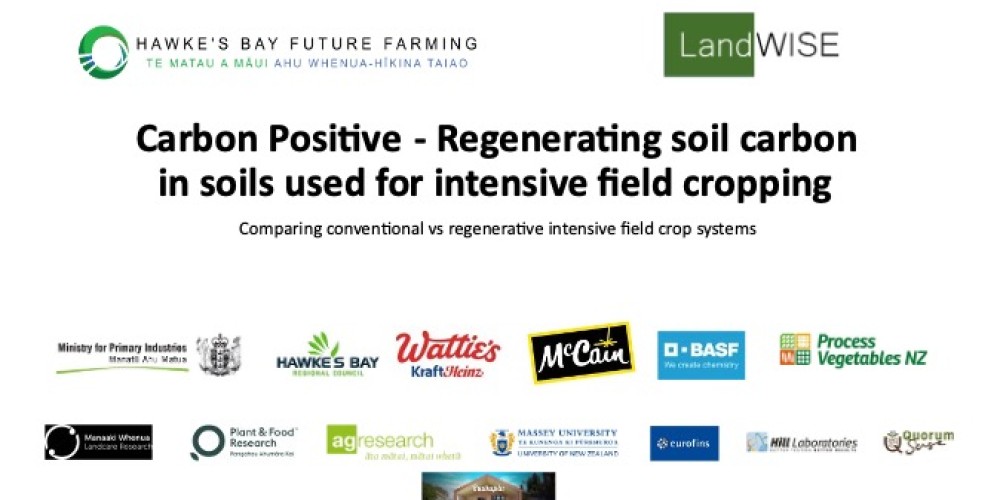
The Carbon Positive Project is a joint project between Hawkes Bay Future Farming Trust and LandWISE, and key project partners MPI, HBRC, HDC, Heinz Watties and McCains aimed at restoring soil health and regenerating soil carbon in Hawkes Bay soils used for intensive field cropping on the Heretaunga plains by comparing conventional vs. regenerative and hybrid growing systems over a six-year trial.
Where conventional systems are typical of best practice systems currently used by partners Watties and McCains, the regenerative system aims to improve soil health, structure and microbial activity by incorporate no/reduced tillage, reduced chemical and synthetic fertiliser use, and focus on the importance of winter cover crops rotations and transition to crops.
The trials compare the three growing systems taking into account inputs, costs based on commercial growing scenarios and outs including yeilds and quality grading.
In each case so far the regenerative trials have had less cost inputs and also less yeild outputs.
What the trial has shown up is the importance of cover crops and transitioning from cover crops, termination and replanting into the next crop. While in conventional and hybrid the systems require interventions such as spraying out with herbcidesi and cultivation of the soils, regen reduce these steps long the lines of the principles of Regen agriculture.
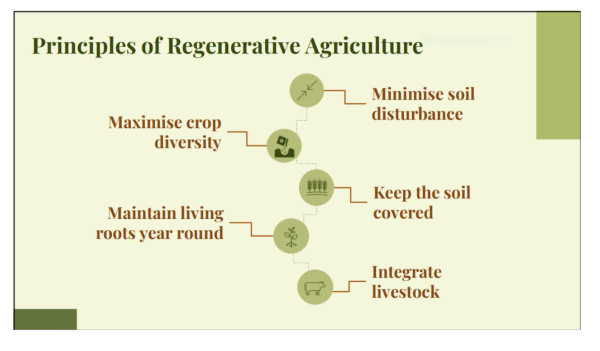
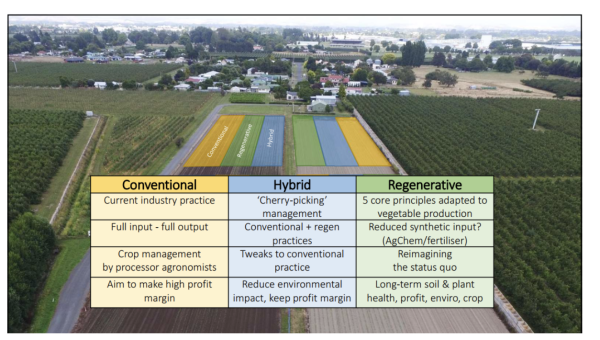
Source LandWISE Dan Bloomer, Alex Dickson
Crops are grown for McCains one year and rotated with Heinz Watties the next and in between cover crops are grown.
The first crop in 2023 was McCains sweetcorn followed by Watties Tomatoes this season.
Carbon Positive Tomatoes: Preliminary Results
Source LandWISE Dan Bloomer and Alex Dickson
Nitrogen
Soil nitrate levels were measured at fortnightly intervals throughout the season to 30 cm using the Nitrate Quick Test procedure and a Nitrachek 404 reader, with leaf tissues sent for laboratory testing in December and January. Soil nitrate levels rose following fertiliser applications at planting and at the start of main fruiting in week seven. A late nitrate application gave a marginal and temporary increase in the regenerative treatment but did not prevent further decreases in the conventional and hybrid treatments (Figure 1). Some additional foliar applications were made and overall, there was little difference in the amount of fertiliser nitrogen added to the different treatments.
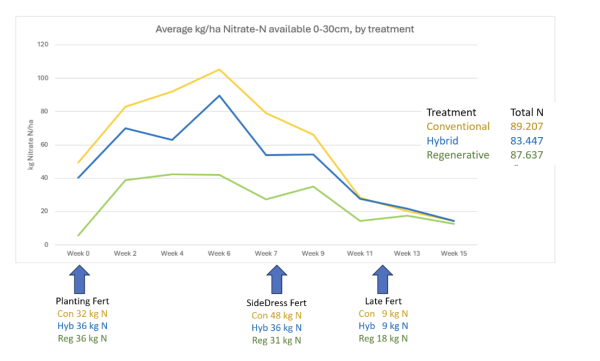
Figure 1 Line chart of soil nitrate levels over time as determined using the Nitrate Quick Test method showing that levels increased following fertiliser applications at planting, side dressing, but were only maintained by a late application 6 weeks before harvest. Regenerative treatment soil nitrate was consistently much lower than the other treatments.
Leaf testing showed slightly higher than recommended leaf nitrate concentrations in late December, but late January leaf testing showed the nitrate levels had dropped below the recommended range in all treatments, with the regenerative treatment at only about half the recommended level which may have further contributed to the reduced tomato canopy size (Figure 2).
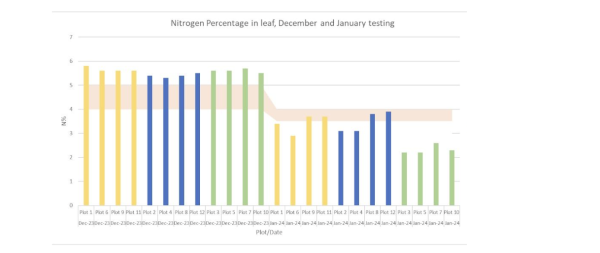
Figure 2 Histogram of tomato leaf nitrate concentration levels measured at the end of December and again in January with the histogram bars showing initially satisfactory to high levels and then lower than recommended levels a month later with the regenerative treatment plots consistently much lower concentrations than other treatments and recommendations. The pale brown stripe shows the recommended nitrate levels for tomato leaf testing in December and in January.
Despite more than 13 t ha-1 DM of cover crop being incorporated in the regenerative treatment, no significant increases in soil nitrate were detected during the growing season. The mean nitrogen concentration in dry mass was 1.2%, representing 141.9 kg N ha-1.
Aerial Canopy Measurements
Weekly ARGOS Aerial mapping drone surveys since Christmas (week 9) were processed and several indices determined. In all cases, the Conventional treatment was highest, Regenerative lowest, and Hybrid in the middle. Most showed a climb until crop day 84 and then a decline, steepening nearer to harvest. The exception was the Modified Chlorophyll Absorption in Reflective Index (MCARI) which is used to measure chlorophyll concentrations including variations in the Leaf Area Index. MCARI values are not affected by illumination conditions, the background reflectance from soil and other non-photosynthetic materials observed. MCARI dropped after crop day 63 (week 9) rapidly between crop day 77 and 84 when final fertiliser was added, after which it rose again steeply over two weeks, before dropping away again to harvest. MCARI best reflected field observations of canopy colour and the agronomists’ assessment of nitrogen deficiency.
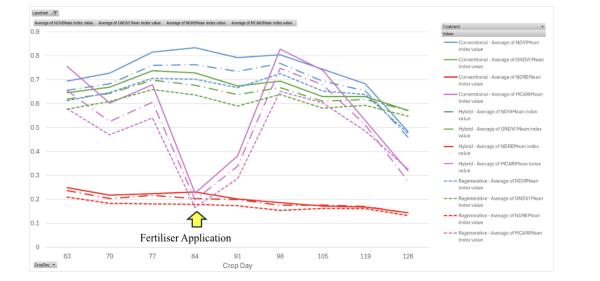
Figure 3 Line chart of aerial survey canopy indices NDVI, GNDVI, NDRE and MCARI showing the conventional plots were consistently highest and regenerative plots lowest index values. MCARI showed most change and appears related to nitrate availability.
Crop Protection Impacts
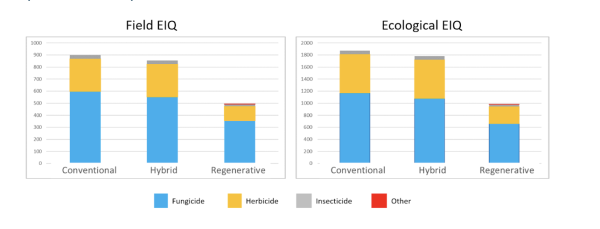
Figure 4 Histograms of the Field EIQ and Ecological EIQ of the three treatments applied to tomatoes in 2023-2024 showing the greatest contributions were fungicides followed by herbicides with insecticides and other products having minimal effect.
The relative toxicities of the crop protection programmes applied to the different treatments were compared using the Cornell University Environmental Impact Quotient (EIQ) model (Kniss & Coburn, 2015; Cornell University College of Agriculture and Life Sciences, 2024; Grant, 2024). The modelling shows that the impact of the regenerative crop protection programme was about half that of the other treatments (Figure 4). The regenerative treatment applied biological products and plant response elicitors in preference to standard chemical options and dropped copper sprays entirely. Herbicide application was also minimised, but not stopped. There was a higher weed pressure in the regenerative plots, but it was restricted to the inter-rows and not thought to effect yields.
Crop Yield
Pre-harvest crop yield assessments were made by collecting all fruit and vine from full 2.00 m bed width transects 0.50 m long at four locations in each plot. Fruit was graded into reds, breakers, greens and rots.
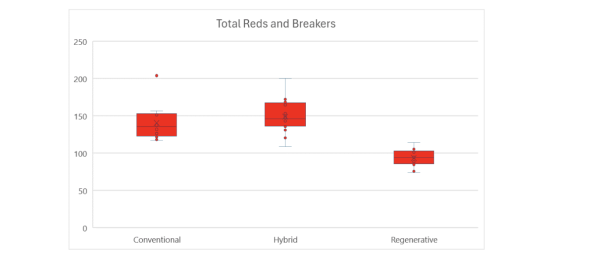
Figure 5 Boxplot of hand-harvest yield assessments showing the weight of red and breaker grade tomatoes collected, showing the conventional and hybrid treatments outyielded the regenerative treatment. Conventional and hybrid are not significantly different.
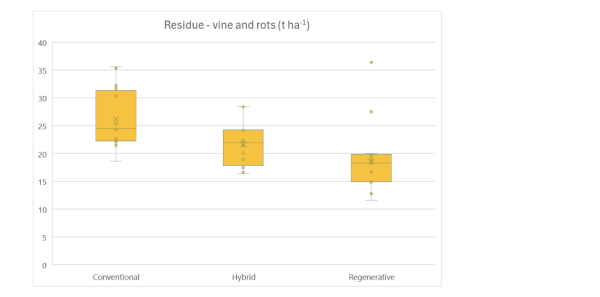
Figure 6 Boxplot of hand-harvest assessments showing the weight of residue vine and rotten fruit. Conventional is significantly different to the hybrid and regenerative treatments, which are not significantly different to one another.

Table 1 Summary of key harvest measurements by treatment
Further analyses show the regenerative treatment had a far higher percentage of green fruit, suggesting its maturity was delayed. Given the slow start of these plants, the possibility that a later harvest date could have been appropriate should be considered.
Soil Moisture
MetWatch data for Ruahapia Road show a lingering soil moisture deficit for the first month after planting. Prior to planting the conventional and hybrid plots had moderate moisture but the regenerative plots were very dry. A simple water balance suggests the plants would have been in severe stress until rain at the end of October, and in some stress until mid-November. Irrigation began on 16 December with 116 mm being applied through the season. A bucket test showed the uniformity was good and the applied depth was consistent with the operating expectations.

Figure 7 Water balance based on weather station data and estimated crop factors for the regenerative treatment plots showing rain and irrigation events and the water balance.
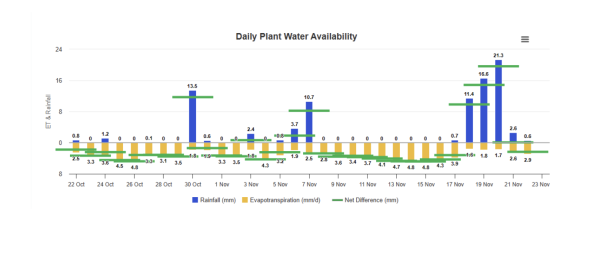
Soil moisture readings were made using a HydroSense II TDR with 20 cm probes with first records made on 16 November.
Join the conversation
Be the first to leave a comment.
Leave a comment
All comments are reviewed before they are published on the website. Your email address will not be published.
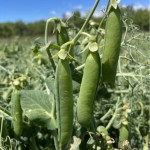
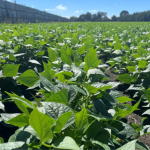

Community Engagement and Knowledge Sharing Strengthen the Carbon Positive Project
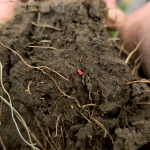

Farewell to Trustee Phil Schofield – A Foundational Leader of the HBFFCT
